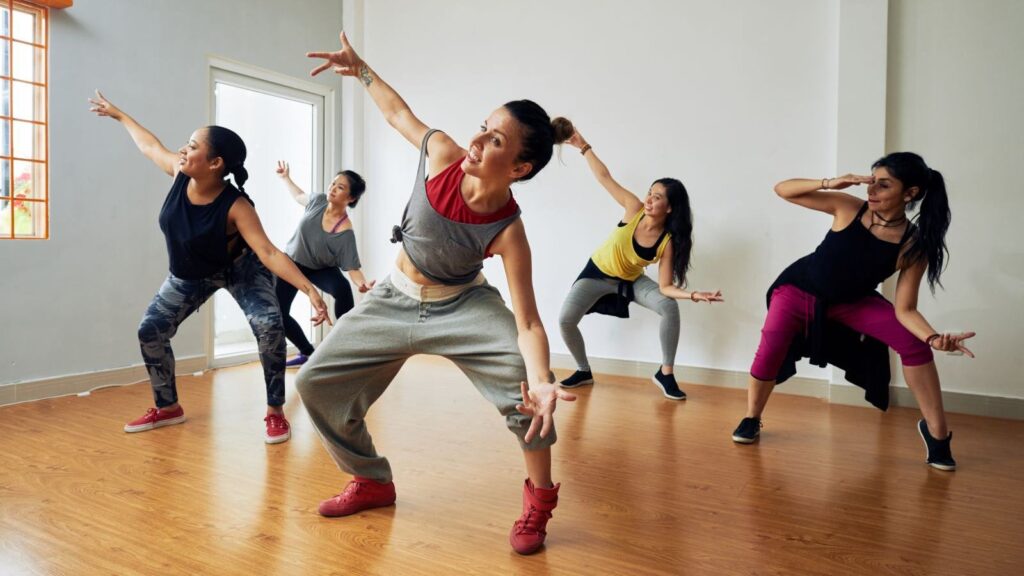De-stressing can help you connect with your mind, body, and environment. Here are some fun and easy dance exercises to relieve stress.
Stress has become an unpleasant companion in our hectic lives. From demanding tasks to tight schedules, it seems like something is constantly pulling us in different directions. Although relaxation techniques such as meditation can be beneficial, many people struggle to incorporate them into their daily routine. Fortunately, there is an enjoyable and energetic alternative: dance exercises to relieve stress. Dance is not just a form of pleasure; it is also an effective stress reliever. Rhythmic movements, concentration on the present moment and the production of endorphins contribute to a feeling of peace and well-being. Find out how to follow these dance exercises to relieve stress.
Exercises to Relieve Stress: Do They Work?
Exercise goes beyond just physical activity; it is an excellent stress reliever. When we exercise, our bodies produce endorphins, which are natural mood boosters that promote emotions of well-being and happiness, according to a study published in the journal Health psychology and behavioral medicine. These endorphins can help reduce the harmful effects of stress hormones like cortisol. Regularly practicing dance exercises to relieve stress also helps reduce muscle tension that can build up during times of anxiety.
5 dance exercises to manage stress
Here are some easy and effective stress-reducing dance exercises that you can follow, as suggested by Zumba expert, Apuorva Sinha.
1.Zumba
Zumba is one of the most effective forms of exercise for relieving stress, as revealed by a study published in the Journal of Dental and Medical Sciences. The vigorous movements and upbeat music trigger the release of endorphins, natural mood boosters that fight stress and improve mood. By requiring focus on music, rhythm, and choreography, Zumba draws attention away from worries, promoting a mind-body connection that grounds you in the present moment. Attending a class provides a sense of community and social interaction, combating feelings of isolation and improving overall mood.
How to do it:
- Choose loose, breathable clothing that allows you to move easily.
- Start with light cardio warm-up exercises, like jogging in place or jumping jacks, to prepare your body for the workout.
- Pay close attention to the instructor’s cues and do your best to follow the rhythm and choreography. Don’t worry about perfection; just have fun and enjoy the movement.
- If you are new to Zumba or have limitations, feel free to modify the moves according to your fitness level.
- After class, cool down with some gentle stretches to improve your flexibility and prevent muscle soreness.
2. Salsa
Salsa dancing is one of the most fun stress-relieving exercises. It significantly relieves anxiety by causing the release of endorphins, which are natural mood enhancers that have both stress-relieving and mood-enhancing properties, as revealed in a study published in the journal Plos One. Concentration on music, rhythm and interaction with the partner distracts attention from worries, creating a contemplative mood. Additionally, the social interaction inherent in partner dancing promotes a sense of community and connection, which combats feelings of isolation and improves overall mood.
How to do it:
You may also like


- Stand with your feet together.
- Step forward with your left foot.
- Shift your weight to your right foot.
- Step back with your left foot.
- Take a slight break.
- Step back with your right foot.
- Shift your weight to your left foot.
- Step forward with your right foot.
- Take a slight break.
- Salsa music generally has a strong, driving beat, often with a “1-2-3” feel. The steps must align with this rhythm.
- Gently shifting your weight between your feet is crucial.
- Maintain an open, inviting posture, with your arms slightly bent and your shoulders relaxed.
3. Aerobic exercise
Aerobics is one of the most effective exercises for reducing stress because it causes the production of endorphins. They are natural mood enhancers that have both stress-relieving and mood-enhancing properties, as revealed in a study published in the International journal of science and research. The repetitive movements and emphasis on music and choreography distract from anxieties, creating a meditative mood. Additionally, exercising helps reduce stress and promote relaxation.
How to do it:
- Warm-up (5-10 minutes): Light cardio, such as jogging in place, and dynamic stretching, such as arm circles, leg swings, and torso twists.
- Aerobic exercise (20 to 60 minutes): This involves sustained, rhythmic activities that increase your heart rate and breathing. Include brisk walking, jumping jacks, or knee strikes.
- Recovery (5 to 10 minutes): Light cardio, like walking slowly. Static stretches, holding each stretch for 30 seconds, such as hamstring, quad, and calf stretches.
4. Hip hop
Hip-hop dance, due to its dynamic nature, is an effective stress reliever. Energetic movements, combined with upbeat music, cause the release of endorphins that reduce stress and improve mood. Hip-hop dancing, by focusing on music, rhythm and choreography, distracts from anxieties and promotes mindfulness. Additionally, the expressive nature of dance allows for a healthy release of held feelings, resulting in reduced stress levels.
How to do it:
- Stand with your feet shoulder-width apart. Move body parts independently, such as shoulders, hips and head.
- Wear comfortable, loose-fitting clothing.
- Keep your arms at your sides.
- Rock your hips.
- Start moving.

5. Belly dance
Belly dancing is a simple form of stress management exercise that causes the production of endorphins, natural mood enhancers that have both relaxing and joy-enhancing properties. The emphasis on music, rhythm and smooth movements distracts from worries, creating a relaxed mood. Additionally, the emphasis on self-expression through movement contributes to the healthy release of pent-up emotions.
How to do it:
- Make circular movements of the hips, clockwise and counterclockwise.
- Raise and lower your hip at the same time.
- Small, rapid vibrations in the hips, chest or shoulders.
- Wave-like movements that travel through the body, starting from the abdomen and moving upwards.
- Graceful arm movements that complement hip movements.
Things to keep in mind while doing these exercises
- Check with your doctor, especially if you have underlying health conditions or haven’t exercised in a while.
- Start cautiously and gradually increase your intensity to avoid overexertion, especially if you’re new to exercise.
- Pay attention to any pain or discomfort and modify your workout accordingly.
- Find a friend who exercises to help you stay motivated and accountable.
- Warm up before and cool down after your workout to avoid injury and reduce muscle discomfort.
Related FAQs
Is it safe to practice dance exercises every day?
While daily dance practice can offer many benefits, it is important to listen to your body. Consistent practice is generally encouraged, but be sure to incorporate rest days to avoid overtraining and potential injury.
When is the best time to practice dance exercises to manage stress?
The best time to practice dance exercises for stress management is when they best fit into your schedule and allow you to consistently incorporate them into your routine. Many find that dancing in the evening helps to unwind after a long day, while morning sessions can provide an energizing start to the day.
#easy #dance #exercises #stress #relief



